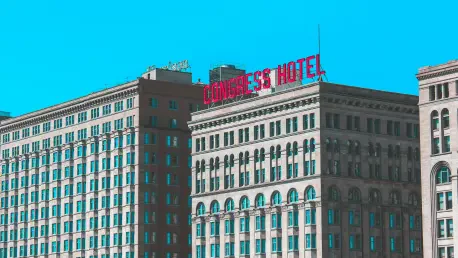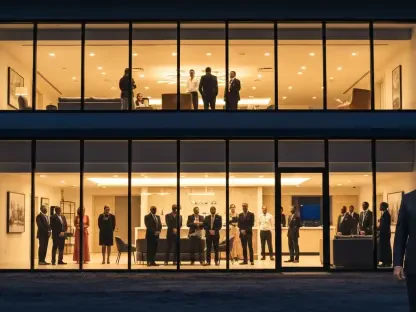Milwaukee is experiencing significant changes in its hotel landscape, driven by strategic shifts proposed by Greg Marcus, CEO of Marcus Hotels and Resorts. Traditionally, increasing hotel capacity was deemed vital for attracting larger conventions. However, ongoing discussions and decisions call this belief into question, suggesting a need to harmonize the city’s convention ambitions with present market realities. The city’s hotel strategy appears to be at a crossroads, where reevaluating convention goals and room allocations could influence economic growth horizons.
Rethinking Hotel Expansion for Conventions
Strategic Realignments in Hotel Investments
Milwaukee’s hotel strategy is evolving as Marcus Hotels recently decided to renovate the Hilton Milwaukee without incorporating additional rooms, signaling a strategic shift. This decision reflects a broader approach that favors sustainable development and optimal room utilization rather than indiscriminate expansion. By not adding rooms, Marcus aims to streamline operations and focus on quality over quantity, potentially setting a new benchmark for hotel investments in the region. The Hilton Milwaukee’s renovation is emblematic of Marcus’s broader vision, which prioritizes maintaining quality service and an engaging guest experience while considering market dynamics. This shift demands careful consideration of local economic conditions and tourism trends to ensure both immediate viability and long-term growth, highlighting a nuanced balance between strategic planning and operational flexibility within the hospitality sector.
Balancing Market Sustainability and Capacity
In Milwaukee, the conversation around hotel capacity is increasingly centered on achieving balance between development and market viability. Concerns about potential strain on resources and economic repercussions arise as the city contemplates increasing hotel accommodations. Excessive capacity may lead to financial complications, as demonstrated by recent industry challenges, including declining occupancy rates. These issues underscore the need for strategic oversight and foresight in expansion plans, emphasizing prudent decisions that align financial objectives with market sustainability. Marcus’s approach advocates deliberate investment, avoiding oversaturation that can exacerbate financial woes. Sustainability in hotel development requires a comprehensive examination of market conditions, competitive landscapes, and long-term economic viability. By engaging with industry experts and stakeholders, Milwaukee can make informed choices about its hotel infrastructure, fostering an environment conducive to both growth and fiscal responsibility.
Shifts in Accommodation Preferences
Evolving Definitions of Successful Accommodation
Throughout Milwaukee, the definition of successful visitor accommodation is being refined, challenging conventional beliefs regarding hotel capacity. As the city seeks efficient accommodations for an increased influx of visitors, convention planners express concerns over the dispersion of guests across multiple small hotel properties. They argue that larger, unified lodgings provide more cohesive experiences, which could be more attractive for hosting conventions. This shift in accommodation preferences reflects broader trends in the hospitality industry, where seamless guest experiences are increasingly valued over sheer volume. The ability to deliver these experiences could directly influence Milwaukee’s standing as a convention destination, prompting a strategic reconsideration of its hotel offerings. Addressing these preferences involves aligning hotel planning with convention goals, ensuring that developments support rather than hinder Milwaukee’s appeal to planners searching for coordinated and centralized lodging options.
Industry Insights on Convention Hotel Demand
Industry experts argue that the development of a large convention headquarters hotel could significantly bolster Milwaukee’s appeal as a convention destination. This aligns with trends in other cities, such as Indianapolis and Cincinnati, where new hotels are constructed in parallel with convention center expansions. The synergy between hotel size and convention volume signifies the inherent demand for comprehensive lodging solutions amid growing visitor volumes. Experts highlight that large hotels can better leverage increased capacity from expanded convention centers, driving further demand for events. By reviewing successful strategies in peer cities and integrating these insights into local planning, Milwaukee can reinforce its competitive positioning. Collaborating with stakeholders, the city can assess potential impacts of new hotel projects and establish frameworks to transition its hospitality industry toward greater scalability matched with convention center capacity expansions.
Recovery and Competitive Challenges
Post-Pandemic Market Dynamics
The hotel industry in Milwaukee is navigating a post-COVID recovery phase, revealing substantial challenges not only in occupancy rates but also in financial stability. Despite heightened demand spurred by major events, such as political conventions, the market experiences vulnerabilities as occupancy growth fails to match room availability increases. This dynamic, illustrated by a 0.7% rise in demand contrasted with a 2.4% swell in the number of rooms, results in occupancy rates lingering at 56%. These fluctuations exacerbate financial stresses, evident in bankruptcies and foreclosures affecting vital properties—trends that call for a comprehensive reexamination of hotel recovery strategies. Events like the Republican National Convention offer temporary boosts but are insufficient to alleviate long-term financial pressures. Ensuring the vitality of Milwaukee’s hotel sector requires adaptive measures and enhanced collaboration between hoteliers and policymakers to navigate post-pandemic uncertainties effectively.
Addressing Competitive Disparities
Amid evolving market conditions, Greg Marcus has proposed legislative measures targeting unfair competition from subsidized new hotels—a stance aimed at safeguarding existing investments. His advocacy for strategies that nurture equitable competition, while preventing subsidized entities from undermining established players, raises pertinent debates concerning property rights and development legislation. Downtown zoning considerations reflect these challenges, as stakeholders seek to balance development incentives against potential monopolistic effects. This nuanced approach calls for constructive dialogues among city officials, business leaders, and the hospitality sector to achieve a fair and thriving marketplace. Policymakers face a delicate task in devising policies that bolster competitiveness without compromising individual property rights. By actively engaging multiple perspectives and exploring innovative zoning solutions, Milwaukee could foster an environment ripe for sustainable hotel growth, protecting existing investments and encouraging equitable expansion.
Potential Pathways and Strategic Considerations
Revisiting Development Policies
In Milwaukee, development policies such as tax-incremental financing (TIF) for new hotel projects spark debate in the context of sustaining competitiveness. Decision-makers are weighing the advantages and disadvantages of such financial structures, evaluating how incentivized financing can influence market dynamics. The ongoing conversation considers zoning adjustments as a method to ensure balanced competition between existing and new entrants. These considerations reflect the city’s commitment to fostering an equitable landscape that supports long-term economic and industry growth. By revisiting development financing schemes and assessing zoning alternatives, Milwaukee could establish a comprehensive framework that promotes fair competition, optimizing both public and private interests to achieve holistic industry development targets.
The Future of the Hilton in Strategic Planning
Greg Marcus’s decision to sell the west tower of the Hilton Milwaukee for redevelopment marks a pivotal turning point, moving away from mere capacity expansion toward preserving strategic investments. This strategy reflects an adaptive approach, reacting to immediate market conditions while safeguarding high-value assets against subsidized competition. Consequently, developers are eyeing the tower for residential conversion—a choice indicative of Milwaukee’s shifting priorities amid evolving economic landscapes. This strategic shift highlights a pragmatically adaptive stance toward hospitality investments, ensuring long-term resilience amid fluctuating market dynamics. By leveraging strategic adaptations in response to immediate threats and opportunities, Milwaukee’s hotel sector can better navigate future uncertainties while reinforcing existing investments.
Historical Context and Future Visions
Prolonged Ambitions for a Major Hotel
Milwaukee’s aspirations for major hotel development span decades, underscored by numerous proposals that have faltered due to financial barriers and environmental issues. The site of the original Randolph Hotel stands as a testament to this enduring ambition, reflecting the community’s long-standing vision for substantial hotel development despite repeated setbacks. The narrative encapsulates a city’s persistent pursuit of growth through grand architectural endeavors, striving to actualize a new convention hotel to drive industry momentum. Local leaders aim to overcome past hurdles and crystallize these long-term goals into actionable projects that bolster Milwaukee’s convention appeal. Whether achieved through innovative financing, environmental accommodation, or strategic partnerships, the city continues to seek pathways that align historical aspirations with contemporary economic imperatives.
Navigating Challenges and Collaborative Opportunities
Milwaukee’s hotel scene is undergoing major transformations prompted by strategic rethinks led by Greg Marcus, CEO of Marcus Hotels and Resorts. Traditionally, boosting hotel capacity was seen as crucial to drawing larger conventions, but recent talks and decisions are casting doubt on this assumption. The conversation now involves aligning the city’s convention aspirations with existing market conditions, indicating a possible shift in focus for economic growth strategies. The hotel strategy is seemingly at a pivotal point, requiring a reassessment of convention objectives and room distributions to ensure they line up with broader economic goals. This reevaluation could pave the way for harmonizing Milwaukee’s convention ambitions with realistic growth projections, fostering balanced development. As the city reimagines its approach, stakeholders are keen to position Milwaukee strategically, ensuring its hotel industry adapts to changing demands and contributes effectively to the city’s economic prosperity.









